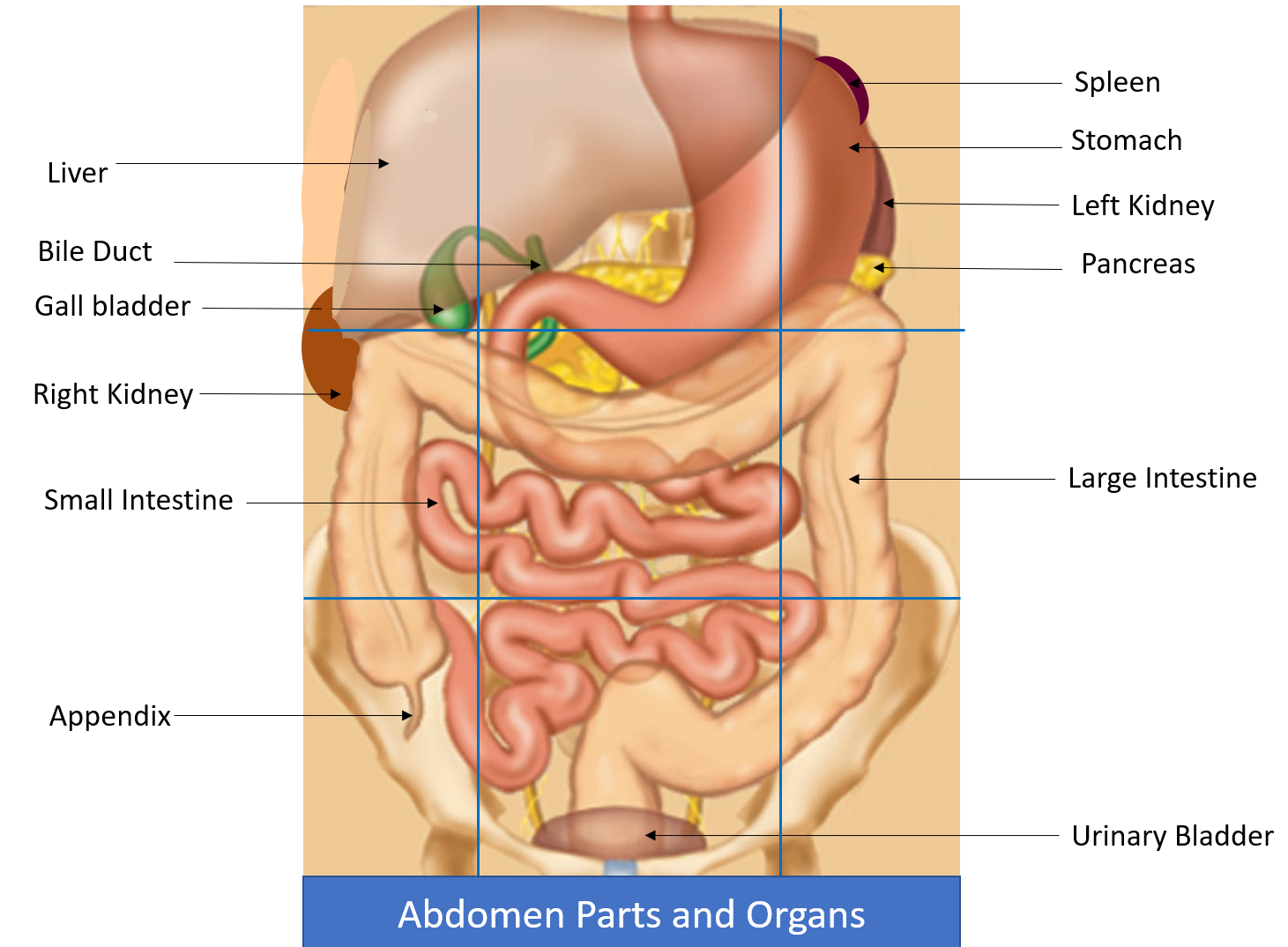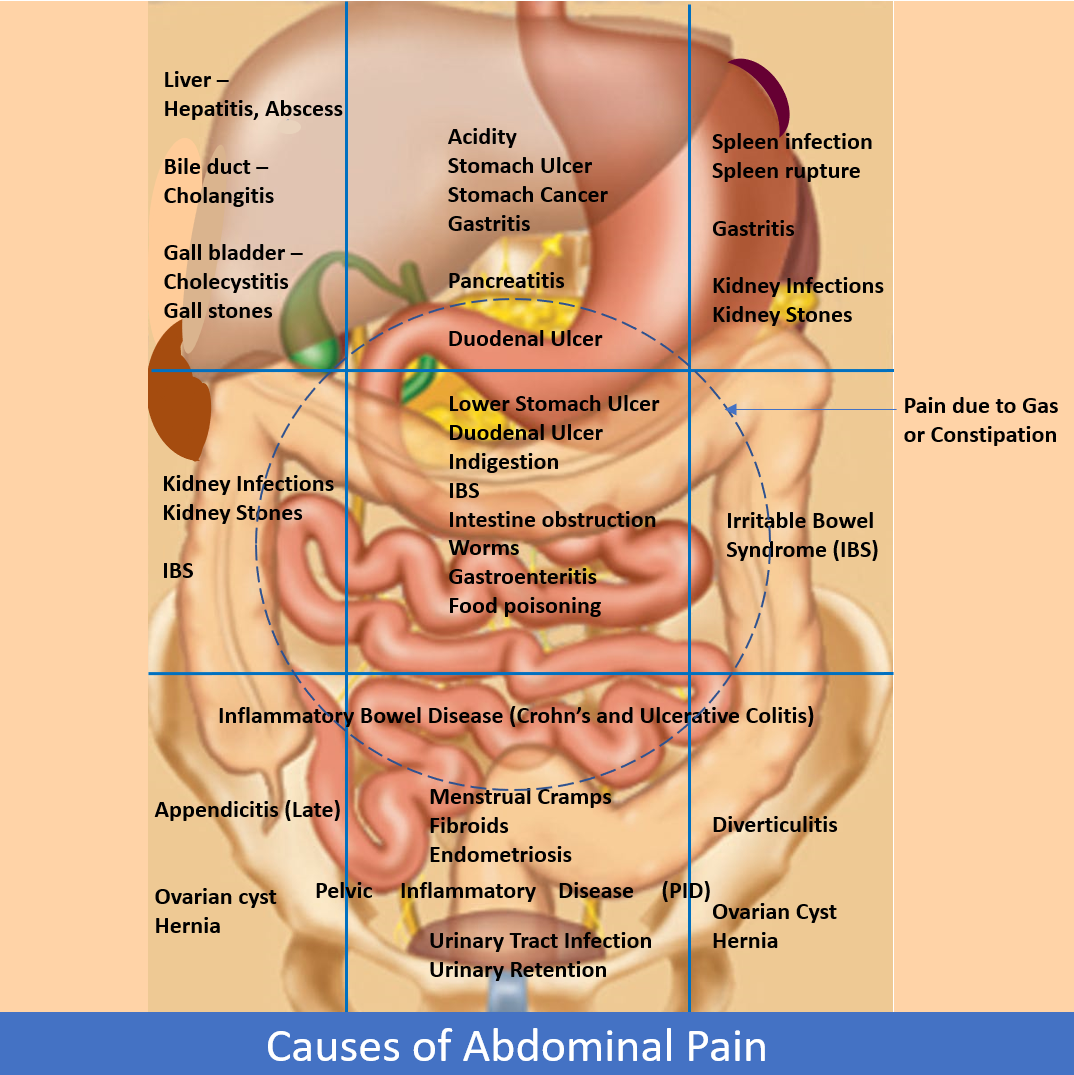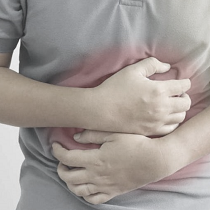WHAT IS INCLUDED IN THE ABDOMEN?
In humans, the abdomen (commonly called the belly or tummy), is the lower part of the torso (trunk). It extends from just below the chest (ribs, heart, lungs) to the pelvis (bones that connect the trunk and the legs). Inside the abdomen are several vital organs as shown. For reference to the location of the abdominal pain and relation to the relevant organ, the abdomen is divided into 9 parts (Right, Central and Left, each having an upper, mid and lower region).



WHAT ARE THE CAUSES OF ABDOMINAL PAIN?
There are several causes ranging from mild ones like gas, indigestion, acidity, bowel irritation or low-grade infections, to more serious causes requiring immediate or detailed medical evaluation and intervention.



HOW DOES ONE ANALYSE OR EVALUATE THE PAIN?
The pain is analyzed on 7 parameters (by the pneumonic OLDCARS) – Onset, Location, Duration, Character, Associated symptoms, Relieving/aggravating factors, and Severity.
Onset
The pain onset may be sudden (acute) or coming and going over a period of time (chronic).
Some examples of acute pains include appendicitis, perforated ulcers, bowel obstruction, food poisoning or infections (gastritis/gastroenteritis), diverticulitis, urinary infections, organ rupture/trauma, hernia getting strangulated, or a stone causing obstruction.
Chronic pain may be due to acidity, peptic (stomach or duodenum) ulcers, indigestion, gas, worms, food allergies, and conditions like Irritable Bowel Syndrome (IBS), Inflammatory Bowel Disease (IBD), and ovarian-uterine causes in females.
Some organs can show both acute and chronic types of pain, for example, acute pancreatitis (due to a large bout of alcohol consumption, infection, trauma or gall stone) and chronic pancreatitis (recurrent pain over a period of time due to regular drinking, smoking, or exposure to chemicals causing damage)
Location
The location of the pain can help in the suspicion and diagnosis of the possible organ involved. For instance, pain due to the liver as in hepatitis will be in the right upper region, while pain due to acidity, and peptic ulcers will typically be in the central upper region, while pain related to the spleen (infection or traumatic rupture) will be in the left upper region. Pain in conditions like gas (trapped wind) may be generalized across the abdomen.
Sometimes the pain may shift with time, like in appendicitis where the pain is initially in the central-mid region of the abdomen but later shifts to the right lower region. The term referred pain is when the pain is felt in a location away from the site of the concerned organ due to the distribution of branches of a common nerve. This is seen in pancreatitis, where the pain is felt going to the back, and in gall bladder stones or inflammation, where the pain is felt going to the right shoulder.
Duration
The duration of the pain includes how long a pain episode lasts and over how much time has it been present if recurrent or chronic.
Character
The character of pain is usually described as:
- dull-aching: hepatitis, IBS, IBD, PID, utero-ovarian causes
- sharp/stabbing: organ rupture, perforation, acute inflammations like appendicitis, diverticulitis, cholecystitis
- burning: acidity, gastroenteritis
- colicky: contracting/spasmodic-coming and going suddenly as seen in bowel obstructions/stones
Associated Symptoms
The associated symptoms which can point to the diagnosis can be nausea, vomiting, diarrhea, fatty greasy stools (steatorrhea), constipation, bloating, belching, fever, or urinary symptoms, and menstrual irregularities.
Relieving and Aggravating Factors
The relieving and aggravating factors are not only important as diagnostic clues but also in planning management strategy. Relieving factors may include rest, passing stools or gas, and vomiting, while aggravating factors can include movement, food, alcohol, and straining or coughing.
Severity
The severity of pain can be a deciding factor for emergency or immediate medical consultation. Mild pain is one that does not disturb functioning, moderate pain disturbs function necessitating some rest, while severe pain has an ‘unbearable’ feel to it with completely impaired capacity.
WHAT ARE THE SIGNS THAT THE PAIN NEEDS MEDICAL ATTENTION AND EVALUATION?
Apart from severity alone, there are some red flag symptoms that should prompt seeking medical evaluation and attention as soon as possible. These include:
- Sudden onset of severe, sharp or colicky abdominal pain
- Dysphagia (difficulty in swallowing)
- Persistent vomiting, or greenish colour vomit
- Hematemesis (vomiting blood)
- Unable to take any liquid/food by mouth
- High fever
- Sweating, shortness of breath
- Feeling faint, disoriented
- Pain disturbing sleep
- Jaundice (yellowing of white of the eye, skin)
- Unexplained weight loss
- Presence of paleness or Anemia
- Change in bowel habit (constipation/diarrhea) lasting for > 3 weeks
- Blood in stools (fresh blood or black tarry stools)
- Pain present or increasing on pressing any region of the abdomen (tenderness)
- Feeling any lump, swelling or mass in any part of the abdomen
- Abdomen looks distended or shows prominent veins
- New-onset abdominal pain in the elderly (>60 years)
- Bleeding irregularities in females
- Blood in urine
- Family history of bowel cancers
HEALTH MEASURES
The doctor may advise investigations like blood/stool/urine tests, ultrasonography, X-ray/scans and endoscopy based on the evaluation of the abdominal pain and other symptoms, as well as a physical examination.
Depending on the condition and diagnosis, the appropriate treatment ranging from diet modification, lifestyle correction, pain medicines (analgesics and antispasmodics), interventions or procedures, and surgery is recommended.
Conditions like gas, indigestion, acidity, peptic ulcers, constipation, and IBS are corrected with diet modification and lifestyle changes, with additional medicines or supplements like digestive enzyme supplements and/or probiotics (friendly gut bacteria aiding in digestion and maintaining a healthy gut). Antibiotics are recommended where appropriate for infections. Inflammatory Bowel Disease will require specific and long-term drug therapy. Certain conditions will require procedural/surgical treatment like appendicitis, diverticulitis, stones, bowel obstruction, and hernia. In women, a gynecological examination is advisable.
Read further on related topics:
Irritable Bowel Syndrome (IBS)
For any query, additional information or to discuss any case, write to info@drvarsha.com, and be assured of a response soon



10 Comments
I was just searching for this info for a while. After six hours of continuous Googleing, finally I got it in your website. I wonder what’s the lack of Google strategy that don’t rank this type of informative sites in top of the list. Usually the top sites are full of garbage.
whoah this blog is excellent i love reading your articles. Keep up the good work! You know, lots of people are looking around for this info, you could help them greatly.
This article includes so much more info than other people, and it’s immensly useful to me. Will be returning to see more writing from you! can I share this?
I truly value your piece of work, Great post.
bookmarked!!, I love your website!
Hello to everyone, the contents present on this website are in fact remarkable for people’s knowledge.
keep up the good work…
Just want to say your article is astonishing. The clarity is simply cool and I can see you are a professional in this subject.
Well together with your permission allow me to seize your feed to stay up to date. Thank you and please carry on the gratifying work.
Pretty niϲe post. I just stumЬled upon your blog and wanted to say that I’ve truly enjoyed surfing around yoᥙr blog posts.
In any сase I’ll be subscribing to your feed and I hope you write again very soon!
I loved your blog article.Really looking forward to read more. Awesome.
Great article! Abdominal pain can be concerning, and it’s important to identify the underlying cause and take appropriate action. I found this blog post very informative.